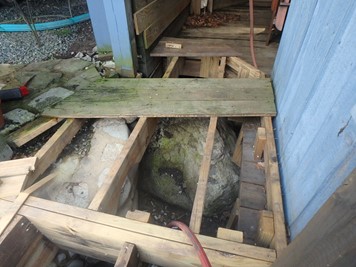
New Hampshire – “the Granite State”
By Nancy Nichols, P.E.
New Hampshire is called “the granite state,” but there is actually very little granite. Most of the rock in NH is metamorphic, not igneous like granite. It would be better to call New Hampshire “the rock state.” We have a lot of rocks. There are many New Hampshire regions where shallow bedrock and/or glacial till with boulders predominate.
It can be difficult to distinguish between bedrock and boulders, but very important for engineering. All boulders can/will move, particularly by frost heaving. (What do we grow best in our gardens? Rocks!) It is not okay to bear a column or footing on a shallow boulder.

In this photo there is a gap between the bottom of the wood column and the top of the boulder because the boulder moved. Now there is nothing supporting the column and loads on it. It is okay to bear a footing on shallow bedrock, even above frost depth, because bedrock essentially does not move.
Glacial till is generally comprised of a mix of soil types: silt, sand, gravel and cobbles or boulders. It is generally very dense because it had the weight of a glacier on it. However, when a silty glacial till becomes disturbed by traffic, animals, etc., it becomes “mud,” by which I mean soft (almost liquid) soil that has a low bearing capacity. So, glacial till can change from “hard as rock” to mud in an instant when disturbed. Disturbed glacial till is very difficult to compact; it should be removed and replaced with compacted granular fill under footings. Elsewhere, disturbed glacial till can often be reused under the guidance of a qualified geotechnical engineer.
Weathered bedrock is also common in New Hampshire. Weathering causes rock to disintegrate into soil. This commonly occurs where there is softer rock and significant water flows through bedrock cracks. During the process of weathering, disintegration along bedrock cracks can cause boulder-size rock fragments. These boulder size rock fragments often lie on slick bedrock surfaces. These bedrock fragments can move and should not be used for support of footings.
House foundations sometimes settle. One reason is that a foundation bears partly on soil, boulder, and/or bedrock. The excavation contractor needs to understand and appropriately respond to subsurface conditions in the absence of a number of explorations and geotechnical assessment prior to the start of construction.
Geotechnical subsurface explorations are required by the building code as part of the planning and design of commercial structures.
More Articles From...
| This Category | Engineered Consultations, Home Repairs, Residential Engineering, Structural Design, Structural Engineering |
| This Author | Nancy Nichols, P.E. |
